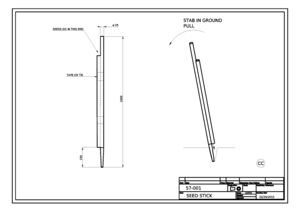
There are a plenty of existing seed stick designs out there, but they are complicated and expensive consisting of many moving parts that can wear and break. This seed stick design is a simple low cost solution to increase the amount of seeds a farmer can plant in given amount of time. It reduces the amount of stress on the back by eliminating the need to bend over.
Understanding the Market[edit | edit source]
Existing seed stick design consist of a mechanical delivery mechanism that insert one seed into the soil from a small hopper. The insertion is triggered by plunging the mechanism into the soil. Although efforts have been made to reduce cost for low income farms, the price is still too much for low income family farms that survive on less than two dollars per day. Any system with moving parts also is subject to wear and failure. Repair of such planters consumes resources and time.
Project Goals[edit | edit source]
The first design is complete. Feel free to use it as is or modify it.
To Do
- Up load CAD file again, not sure what happened to them.
- Distribute idea to those who need it. Get it out in the wild.
Design[edit | edit source]
PDF for download. [1]
The design consists of one solid dowel made of local material such as bamboo. This section is long enough for a person to stab into the ground from a comfortable standing position. The stabbing tip is slightly tapered to aid in creating a hole for a seed. The second section is hollow and attached to the solid dowel using tape or twine. My first prototype used an old handle from a hoe and a length of old water hose taped together.
Operation[edit | edit source]
As seen from the attached print, the seed stick is stuck into the soil to create a hole. Pulling back on the stick opens the hole for planting. Drop a seed into the upper end of the hollow section allowing the seed to drop into the hole. Remove the stick and stamp down on the hole covering the seed. Move a few inches and repeat.
Discussion[edit | edit source]
Your discussion.
Next Steps[edit | edit source]
One option for this design is the addition of some form of depth control. Various seeds require various depths for proper growth.
Conclusions[edit | edit source]
This design is cheap and can be made from local parts. I have personally used my first prototype to plant a large amount of corn seed.
References[edit | edit source]
Contact details[edit | edit source]
wholloway@zoho.com